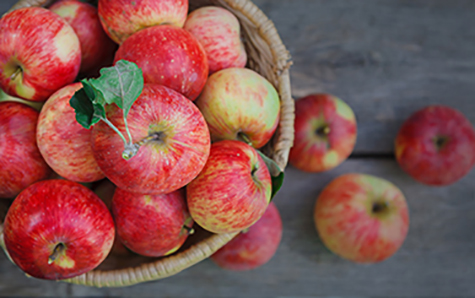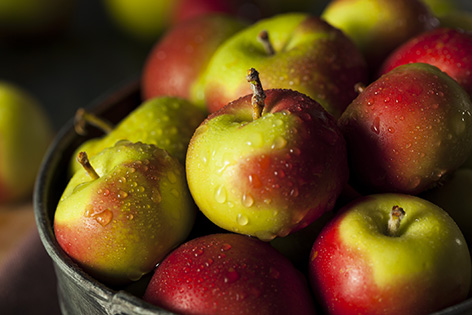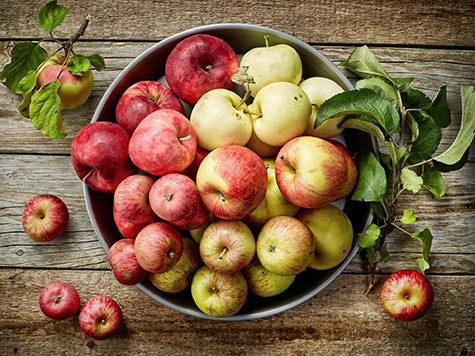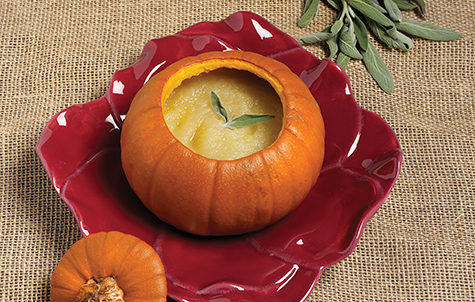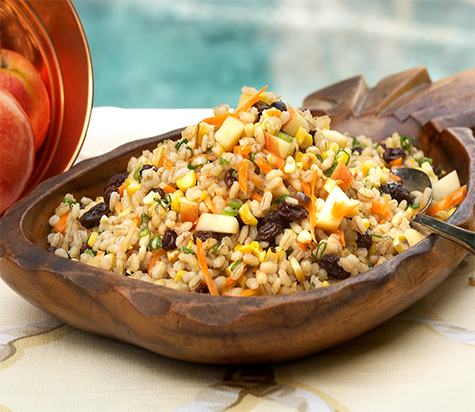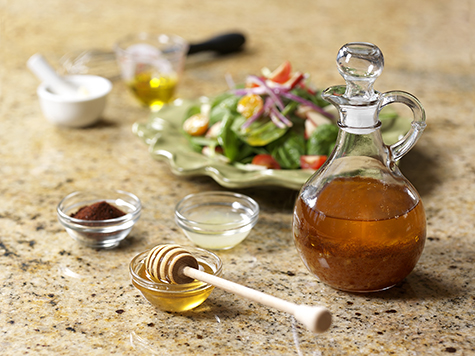All About Apples – They’re Healthy to the Core

There’s good reason for the saying, “An apple a day keeps the doctor away,” although as a small child, it upset me, because my father was a doctor. Part of me was afraid that if I ate an apple every day, I wouldn’t see my beloved dad. Luckily, I outgrew this fear and came to appreciate apples for the incredibly nutritious fruit that they are.
Apples are the second most popular fruit consumed in the U.S. after bananas. They are enjoying a golden age right now, with a number of delicious (as opposed to Delicious—though they’re good too) new varieties that are irresistible. Now that it’s fall, the apples you see in stores are mostly from America’s best growing regions—Washington State, Michigan, New York and New England. Yes, there are apples in stores in the spring and summer, but most of those have made a very long journey from New Zealand or Chile, so now’s the time to enjoy the fresh American crop.
Honey Crisp is one of the most popular new apples. Envy are incredibly sweet and crisp. Jazz are a little bit tart. Ambrosia are amazing and beautiful Opal apples are bright yellow like a Golden Delicious, and the flesh is very crisp.
Apples are full of disease-fighting vitamins, antioxidants and fiber, making them one of the best fruits for enhancing health. Only cranberries have higher levels of antioxidants. Apples are number-one for the proportion of free phenolic compounds, which means they may be more easily absorbed into your bloodstream. Ideally, eat apples peel and all, because the peel is where more of the vitamins and antioxidants are. Also, keep in mind that healthy as they are, apples are one of the crops that can be highly contaminated with pesticide. For the full benefit, buy organic apples whenever possible.
A whole medium apple contains about 90 calories and 4 g of fiber. Here’s what else makes apples highly effective FoodTrients:
Whiter, healthier teeth and gums – An apple won’t replace your toothbrush, but eating apples stimulates the production of saliva in your mouth, reducing tooth decay by lowering the levels of bacteria while scrubbing the surfaces of your teeth.
- Weight loss– Apples satisfy hunger with fewer calories and they contain bulk, which enhances a feeling of fullness. Eating a whole apple before meals can lead to consuming 15% fewer calories.
- Loaded with vitamins and minerals – Especially high in vitamin C and vitamin A, apples are a powerful antioxidant that helps the body resist infection and fight free radicals that cause inflammation. Apples are a good source of B-complex vitamins, which help support metabolism. Apples provide minerals including iron, copper, zinc, phosphorus, calcium, and potassium, which are important in helping to control heart rate and blood pressure.
- Lower cholesterol and heart disease – Studies suggest that the antioxidant compounds found in apples help preventLDL cholesterol from oxidizing, which can cause inflammation and lead to heart disease. Apples contain soluble fiber, which has also been shown to lower cholesterol levels.
- Cancer fighting – Apples contain the flavonoid, quercetin, which a 2000 Mayo Clinic study suggested helps prevent growth of prostate cancer cells. Another study at Cornell reported that phytochemicals in apple skin inhibited reproduction of colon cancer cells by 43%. The presence of strong antioxidants in apples prevent oxidative stress and the accompanying damage done to cells’ DNA that are linked to vascular diseases and cancer.
- Help prevent osteoporosis– Apples are a great source of dietary boron, a mineral that has bone building Not having enough boron in your system can also contribute to the symptoms of arthritis.
- Diabetes prevention – Three servings of apples (and other fruits, such as blueberries and grapes) are linked to a lower risk of type II diabetes. Apples contain compounds that may lessen the absorption of glucose from your digestive tract and regulate blood sugar levels.
Now that I’ve shown you all the benefits of apples, it’s time to enjoy them! Right now is peak season, so check out exciting new varieties in the produce department or farmers market. One of my favorite, easy-to-make dishes for fall is my Stuffed Sugar Pumpkins recipe (below), which is featured in my latest cookbook, The Age Beautifully Cookbook. Sugar pumpkins are mostly used as decoration in the fall months. That’s a shame because they are the best variety of pumpkin to cook with. Their flesh is less stringy and watery than the larger jack-o’-lantern pumpkins. I also like to roast them for a nice holiday side dish. My Apple Barley Salad recipe (see below) is also a great fall dish.
For dessert, try my Pear-Apple Tart from my first cookbook, The Age GRACEfully Cookbook. The recipe is inspired by the classic French tarte tatin. This luscious dessert is made with quercetin-containing apples, pears, which contain important trace amounts of copper, pecans and cinnamon, which is high in antioxidants. When used in sufficient amounts, cinnamon has the added benefit of anti-inflammatory properties and may help stabilize blood sugar levels.
Apples are truly a versatile super food!
Stuffed Sugar Pumpkins
SERVES 4-6
Salt or salt substitute and freshly ground black pepper to taste
About 4 cups applesauce
Cinnamon (optional)
- Preheat the oven to 350 degrees.
2. Prepare the pumpkins: Carefully remove the tops of each pumpkin, scoop out the seeds and fibers with a spoon, and clean the pumpkin tops.
3. Salt and pepper the cavity of each pumpkin. Add cinnamon to taste, if desired.
4. Spoon the applesauce into the cavity of each pumpkin. Depending on the size of the pumpkin, you will use anywhere from ¼ cup to 1 cup of applesauce per pumpkin. Fill the pumpkin to just beneath the top rim.
5. Replace the pumpkin tops and roast in the oven at 350 degrees for 45 minutes–1 hour or until they are tender but not mushy. You can garnish with sage leaves or top with a little cinnamon.
Barley is a great source of fiber, B vitamins, and selenium. For the corn kernels, I prefer fresh-roasted corn, but you can use thawed frozen corn kernels, too. The apples can be any variety or color that you like, or even a combination. All apples contain quercetin, a compound that helps support the immune system, thereby “keeping the doctor away.” Raisins provide antioxidants and resveratrol, the same compound found in red wine. My Honey-Lime Dressing increases the antioxidant, anti-inflammatory, and immunity-boosting components of this recipe.
SERVES 4-6
Ingredients
1 cup cooked barley
½ cup corn kernels
2 2/3 cup chopped apples, peels on
2 Tbs. chopped scallions
½ cup shredded carrot
½ cup raisins
Sea salt and ground pepper to taste
1 recipe Honey-Lime Dressing, garlic omitted
Directions
- Rinse the barley in cold water to separate the grains.
- In a large bowl, mix together the barley, corn, apples, scallions, carrot, and raisins. Season with the salt and pepper.
- Toss with garlic-free Honey-Lime Dressing.
YIELDS about 1/4 cup
1 1/2 Tbs. lime juice (about 1 lime)
1 1/2 Tbs. honey
1 Tbs. extra-virgin olive oil
1 minced garlic clove
1/2 tsp. chili powder
Sea salt to taste
Combine all the ingredients in a container with a tight-fitting lid and shake until well blended.
